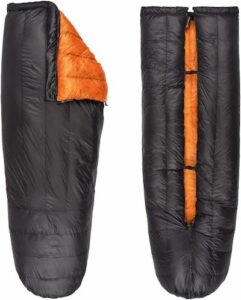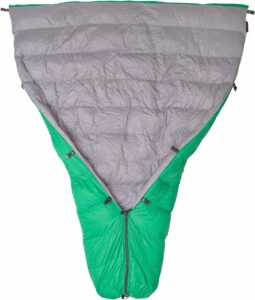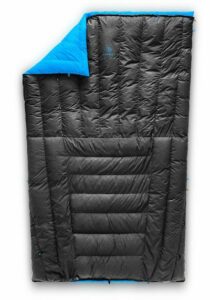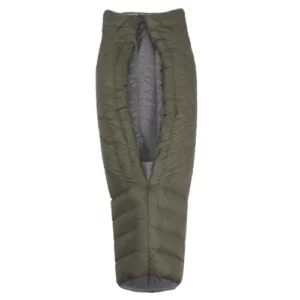The secret to a successful backpacking trip isn’t about the snacks you bring or the company you keep. It’s all about getting enough shut-eye and having a dialed-in sleep system. Because after a long day carrying that heavy pack, your muscles crave some TLC to gear up for tomorrow’s adventures.
These days, more people are opting for backpacking quilts as a lighter alternative to sleeping bags. And they’re taking the backpacking community by storm.
A typical backpacking quilt will run you anywhere between $300 and $550. But cost isn’t always the most reliable indicator of quality. Quilts also come with a learning curve. Despite the hype, they’re not everyone’s cup of tea. So, if you can’t borrow a quilt from your ultralight buddy, save your wallet the agony by testing a more budget-friendly option first.
This guide will reveal everything you need to know when choosing a backpacking quilt, along with our top five budget-friendly picks. We’ll also discuss how to maximize the lifespan of your quilt with proper care and maintenance tips.
What to Consider When Choosing a Budget Backpacking Quilt
- Price Range and Budget: Before buying a backpacking quilt, make sure you have a realistic budget in mind. You’re not guaranteed a better product because it’s more expensive. Regardless of your budget, any backpacking quilt worth its salt should feature a lightweight design, high-quality insulation material and baffling, and durable fabric.
- Weight and Temperature Rating: A backpacking quilt is basically a blanket with a footbox, while a sleeping bag is a fully enclosed cocoon-like structure, often called a “mummy bag” because of its shape. Most quilts don’t have a hood or zipper and feature an open-back design, so the user has more room to move around. These modifications reduce the quilt’s weight without compromising its heat-retaining capabilities. However, if you’re a cold sleeper, you’ll benefit from more down material in your quilt. Keep in mind, this will add some weight (a 10-degree quilt weighs more than a 20-degree quilt), but you can offset this by trimming other items from your pack.
- Insulation Type: Like sleeping bags, you have two options for filling your backpacking quilt: synthetic or down filling. Generally, synthetic insulation is more cost-effective, offers better moisture resistance, and is hypoallergenic, but adds extra weight and bulk to a backpack. On the flip side, down insulation offers unbeatable warmth for its weight, packs down well, and breathes well, but it requires careful maintenance and runs at a higher price point. When choosing a down filling for your backpacking quilt, consider your sleeping preferences, weather conditions, and budget considerations.
- Size and Fit: The length of the quilt should cover your body from head to toe, leaving no areas exposed to the cold. Choose a width allowing free movement and full coverage when lying on your side or back, ensuring no drafts can sneak in.
- Stock or Custom: Stock quilts are the cheaper, off-the-rack option that’ll work for most backpackers’ needs. While they may not satisfy every item on your wish list, stock quilts are readily available and won’t break the bank. On the other hand, custom quilts are like the tailored suits of the backpacking world, designed specifically for your backcountry sleeping needs. Custom quilts are more expensive and require longer lead times since the manufacturer handcrafts them to fit your requirements. I recommend investing in a custom quilt once you’re confident it’s the right choice for you.
- Features: Quilts are more than just backless sleeping bags; they come with a bunch of nifty features to improve your backcountry sleeping experience. Consider footbox options (i.e., sewn, adjustable, or removable) based on your preference for freedom of movement and heat retention. Draft collars minimize heat loss around the neck area, keeping you snug as a bug. While attachment devices, like pad straps or clips, anchor your quilt to your sleeping pad, keeping cold spots and slippage at bay.
Top 5 Budget Backpacking Quilts for Backpacking and Hammock Camping
1. OneTigris Featherlite
 MSRP: $74.98
MSRP: $74.98
Weight: 2 lb. 3 oz.
Temperature rating: 41°F
Product dimensions: 78 x 33.6 in.
The OneTigris Featherlite is a hammock-dweller’s dream. With its synthetic fill weighing approximately 35 ounces, this quilt conveniently folds up to the size of a gallon jug, making it easy to carry in your backpack or on the go.
When unfolded, it provides a generous sleeping space of 6.5ft by 2.8ft. Crafted from tough 20D ripstop nylon and lined with smooth polyester pongee, it offers the durability and comfort you can expect from top-of-the-line quilts. The Featherlite is rated for 41°F. While not ideal for cold-weather hikes or extended thru-hikes, it’s a fantastic choice for hikers who want to experiment with quilts or need something to cover them up during hot summer nights outdoors.
For hammock campers, I’d recommend combining the Featherlite with a lower-rated under quilt to create an insulation combo that even Jack Frost would envy.
View on Amazon | View on OneTigris website
2. Featherstone Moondance 25
 MSRP: $219.99
MSRP: $219.99
Weight: 1 lb. 7 oz.
Temperature rating: 26°F
Product dimensions: 75.6 x 53.9 in.
Featherstone’s Moondance quilt offers affordable warmth for tent camping and doubles as a versatile blanket or under quilt for hammock campers. The snap neck closure and draft collar prevent cold air from seeping in and body heat from escaping.
The Moondance knows how to pack a punch without taking up too much real estate. Weighing in at just 27 ounces, this quilt allows you to prioritize the essentials in your pack (like snacks – and more snacks).
Rated down to a 26°F, the Moondance shines with its killer weight-to-rating-to-price ratio, making it a steal for budget-savvy hikers searching for a quilt to keep them cozy during their three-season adventures. Under the hood (or rather, under the quilt), you’ll find RDS Certified DOWNTEK Duck Down ready to blanket you in warmth.
It’s worth mentioning some users have complained about the lack of down fill inside the quilt or its sparsity in certain spots. And while the Moondance won’t make you impervious to a downpour, most quilts don’t, its performance-based 10D nylon shell is no slouch when shedding raindrops.
View on Amazon | View on Walmart | View on Featherstone website
3. Paria Thermodown 15
 MSRP: $179.99
MSRP: $179.99
Weight: 2 lb. 3 oz.
Temperature rating: 15°F
Product dimensions: 78 x 56 in.
Paria’s Thermodown quilt is designed to deliver maximum warmth without the bulky weight of conventional sleeping bags, thanks to its exceptional down insulation. Paria officially rates it for temperatures as low as 15°F, but the manufacturer advises adding 5-10 degrees for a more realistic estimate.
I mentioned this is a down-filled quilt. High-quality, untreated down already has naturally water-repellent oils left by the geese. Hydrophobically treated down absorbs less water than untreated down and won’t clump as easily when wet. But just because down is treated doesn’t mean it won’t get wet in rainy or humid weather. So if you’re backpacking in an area with a lot of precipitation, this may be a deal breaker.
The quilt comes with a single strap that slips over your sleeping pad. But I’ve found that one pad strap isn’t enough to keep out the chill during super cold, drafty nights. Paria also includes a compression sack to minimize packed volume and a mesh storage bag to keep your quilt safely stored away when not in use.
View on Paria website | View on Amazon
4. Zenbivy Light Quilt 25
 MSRP: $279.00
MSRP: $279.00
Weight: 1 lb. 4 oz.
Temperature rating: 25º F
Product dimensions: 78 x 54 in.
Zenbivy is the brainchild of former Sierra Designs VP, Michael Glavin. The cottage company set out to create a sleeping bag that would give users the same comfort they would find at home. The cottage gear company produces backpacking quilts, mattresses, and pillows.
Their Light Quilt is built with super soft 20D fabric that feels like silk against your skin. You can choose between two footbox designs: the brand’s proprietary sewn Fast Footbox or a convertible footbox that can unclip to lay completely flat—no more zipper battles or unwelcome cold air—just pure comfort and peace of mind.
Where the Light Quilt shines is its carefully engineered baffle system that evenly distributes the high-quality 800-fill power insulation, preventing drafts and retaining warmth. Overall, it provides an exceptional warmth-to-weight ratio that rivals even the most premium alternatives on the market. If the Light Quilt is out of stock (Zenbivy is growing fast), check out their Core Quilt model for a stripped-down version that’s cheaper without compromising quality.
5. Hammock Gear Economy Burrow
 MSRP: $224.95
MSRP: $224.95
Weight: 17.67 oz
Temperature rating: Starting at 40°F
Product dimensions: 74 x 50 in.
Hammock Gear’s Economy Burrow quilt has won the hearts of hammock enthusiasts and tent campers alike. This budget-friendly ultralight quilt is a force of nature. It flaunts a sleek exterior, thanks to its 20D nylon taffeta fabric, boasting a DWR coating that repels moisture like a pro.
Not to mention, its internal calendared finish ensures the down filling stays in place, a not-so-insignificant detail you’ll be glad Hammock Gear didn’t overlook on a cold, windy night. The Economy Burrow contains ethically sourced, 850-fill power down. The manufacturer recommends upgrading to their wide-width option if you’re buying for a ground sleep system.
View on Hammock Gear website | View on Garage Grown Gear
How to Extend the Life of Your Backpacking Quilt
Properly Store Your Quilt
Before putting your quilt away, make sure it’s clean and dry. Excess moisture can cause mildew to grow and damage your quilt. Give it a good shake down to remove any crumbs, dirt, and debris that hitched a ride home with you from the woods.
If it’s dirty, follow the quilt manufacturer’s washing instructions (more on that below or dig into our dedicated guide to washing your sleep gear here).
Quilts love their space, so avoid cramming them into tight spaces. Instead of stuffing it in your closet, hang it or place your quilt in a ventilated storage bag; this will allow your quilt to retain its loft and fluffiness. Find a cozy spot for your quilt that’s cool, dark, and dry. Sunlight and extreme temperatures can wreak havoc on the delicate fabric and insulation.
Wash Your Quilt
Your faithful backpacking quilt has been through so much, and now it deserves some pampering. Use the following tips to keep it fresh, clean, and ready for your next outing under the stars.
Start by carefully reading the care instructions from the manufacturer. For small marks or stains, begin with spot cleaning. Treat those pesky marks with a gentle detergent or specialized cleaner.
Opt for a gentle, low-agitation cycle on your washing machine when it’s time for a thorough cleaning. A quick word of caution, washing machines are tough on hiking gear. Never wash your quilt in a top-loading washer with an agitator. Doing so can rip the delicate materials of your quilt. Front-loading machines at a laundromat are your safest bet.
Use a mild detergent specifically designed for delicate fabrics like Nikawax. Aggressive cycles and harsh detergents can cause your quilt to lose its loft faster than a deflating balloon.
After the washing cycle, rinse your quilt one more time to remove all the soap. When it comes to drying, air drying is the best option. Usually, it’s safe to use a dryer on low heat for most backpacking quilts. If you encounter clumping bits of down, throw in a few tennis balls to break them up. Remember, cleaning a quilt can be a lengthy process, so practice patience and avoid throwing it into your dryer on high since excessive heat can damage the insulation.
Bring Accessories to Keep You Warm at Night
Sometimes, even the warmest quilt needs a little backup to combat the icy chill of the night. Here are some extra quilt accessories to help you sleep better in your tent or hammock.
- Silk Liner: Silk is excellent at trapping heat, making your quilt even warmer, especially if it’s not cutting it in colder temperatures.
- Quilt Clips: Quilt clips attach your quilt to your sleeping pad, creating a cozy enclosure and preventing cold air from sneaking in.
- Balaclava or Hood: An insulating balaclava or down hood can save you from a chilly wake-up call in the middle of the night.
- Down Booties: Chilly toes? Not anymore. Grab a pair of down booties that conform to the natural shape of your feet, giving you a snug, supportive fit.
Who Am I To Judge?
You can trust that I’ve put in the legwork (literally) to know what works and what doesn’t in the backcountry. I’m a bit of a gearhead, always stoked to put my equipment through its paces on long journeys or shorter jaunts.
But it’s not just about the gear for me. I’m genuinely passionate about making the outdoors an accessible place for everyone. So while your gear choices matter, it’s equally important to arm yourself with the knowledge to make informed choices. I can recommend you products until I’m blue in the face, but I’d much rather give you all the tools and resources so you can decide for yourself.

Ash Czarnota is a freelance writer based in Southern California with over 3,000 trail miles under her feet. She is the founder of Go Galavanting, an online community to celebrate adventurous women and highlight emerging thought leaders in the outdoor industry. A PCT alumni, Joshua Tree enthusiast and burgeoning climber, Ash uses her outdoor experiences to craft content that educates and inspires a rising generation of adventurers to embrace their inner wild. Connect with her on Instagram (@salty_millennial).
